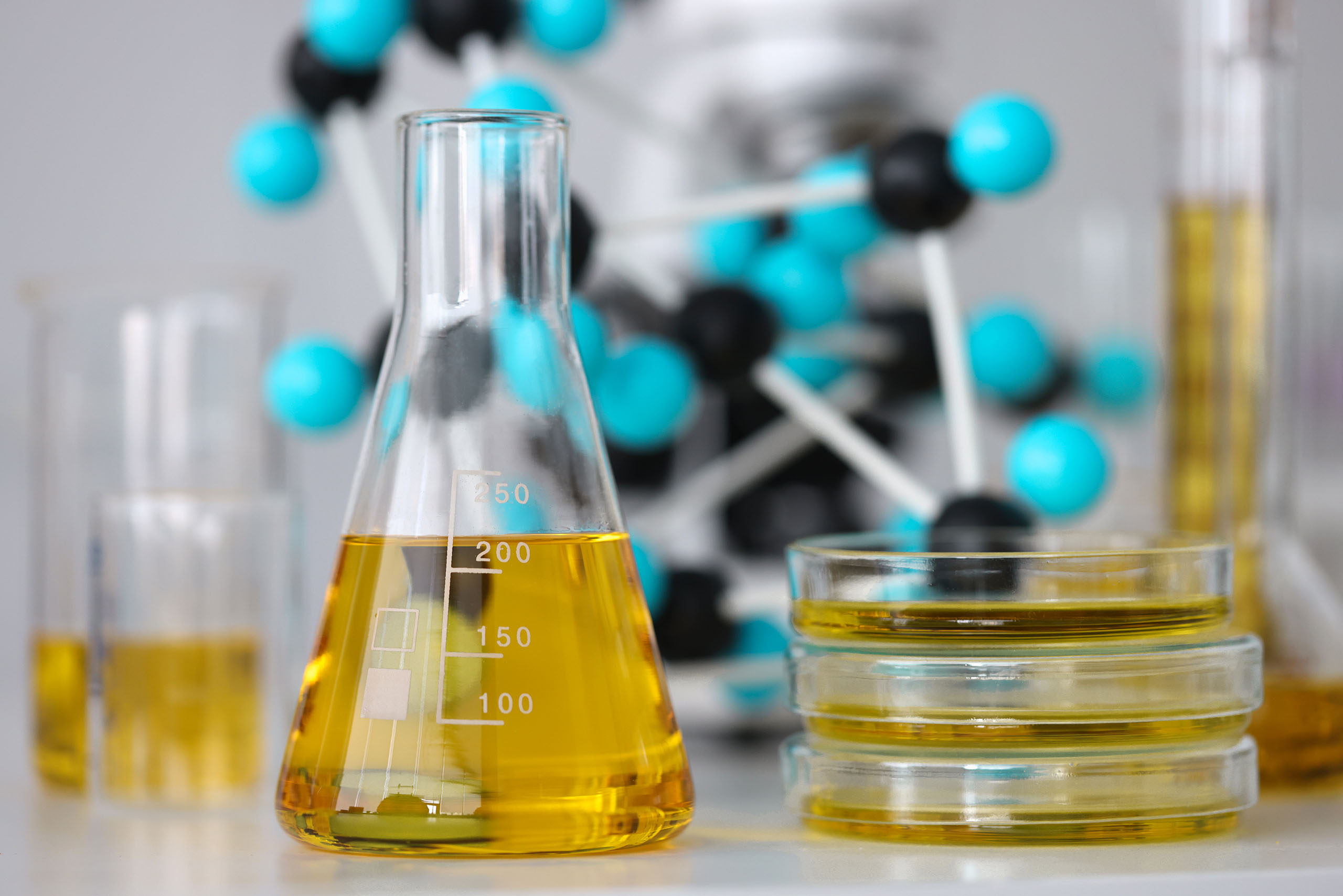CHALLENGING POLICY
Fuel For Thought: Are Emerging Scientific Technologies the Future of the Internal-Combustion Engine?

The internal-combustion engine is far from dead, and emerging synthetic and related carbon-neutral fuels are just a few of the advancements offering a cleaner future amid ever-stricter emissions standards.
By Mike Imlay
Judging from the headlines, you'd think the internal-combustion engine (ICE) is not long for this world. Europe and U.S. governmental bodies are passing ever more stringent climate measures and incentivizing zero-emissions powertrains. Meanwhile, OEMs are ramping up battery-electric vehicle (BEV) production and shifting resources away from traditional engine development. But dig beyond the headlines and you'll find that the reports of the ICE's death are greatly exaggerated.
"Gasoline-powered vehicles will continue to rule the roads in the U.S. for a long time to come," said Gavin Knapp, director of SEMA Market Research. "There are over 280 million ICE cars and trucks on the road now, and more are selling each year. While sales of alternative-power platforms, particularly electric cars, are ramping up, they are still a small fraction of new-vehicle sales at this point. Our current forecast shows that it will take more than a decade for electric vehicles to reach even 50% of new-vehicle sales, so IC engines will definitely be a main component of the vehicle mix for the long haul."
That fact has many industry companies taking a fresh look at synthetic fuels as solutions whose moment has come. Last year, Bosch announced the development of Blue Gasoline in partnership with Shell and Volkswagen. Following on the rollout of R33 Blue Diesel, the new fuel represented one of the latest salvos in the low-carbon fuel market. In its press announcement, Bosch stated that Blue Gasoline "contains up to 33% renewables, ensuring a well-to-wheel reduction in carbon emissions of at least 20% per kilometer driven."
"This means a fleet of 1,000 VW Golf VIII 1.5 TSIs alone could save more than 230 metric tons of CO2 per year, assuming an annual mileage of 10,000 kilometers each," the company explained, adding that Shell would offset the remaining carbon emissions from Blue Gasoline usage through certified offset arrangements.
"On the road to climate-friendly mobility, we must ensure that we don't leave any technical opportunities untapped, starting with electrobility and ending with renewable fuels," asserted Dr. Uwe Gackstatter, president of the Bosch Powertrain Solutions division.
Bosch, Shell and VW are not alone in bringing new fuels to market. In December 2021, VP Racing Fuels also announced that it was making advanced bio-renewable components available for adaptation with the company's race fuel portfolio. In its announcement, the company noted that it continues to develop and test race fuels to meet the upcoming renewable fuel requirements of multiple race series, including Formula 1 and IMSA.
"With enhanced concern over the global environment and an ever-increasing demand on the transportation of people and goods, government regulatory authorities continue to push for more stringent regulations on pollutants and CO2 emissions," explained Mark Walls, VP's director of R&D and fuel technology. "Auto manufacturers continue to pursue advanced powertrains such as electric and hybrid-electric vehicles to address this problem, but we felt that onboard fuel could play a part."
But what exactly are synthetic fuels? Known alternatively as synfuels, renewables, biofuels or carbon-neutral fuels, they are usually liquid fuels produced through the hydrocarbonization of coal, natural gas or biomass feedstocks. Although not derived from fossil sources like crude oil, some liquid synthetics can serve as direct "drop-in" fuels—easily substituting for gasoline or diesel in an ICE vehicle with little or no modification.
Closely related, eFuels are produced through a wind or solar electrification process that creates hydrogen, which is then combined with carbon dioxide extracted from the atmosphere or from industrial processes such as iron smelting. The resulting synthetic fuel can then be refined into eFuel gasoline or diesel.
An Ongoing Debate
Eco-friendly as they sound, bio-fuels have their detractors, particularly among stalwart electrification fans. Business media giant Forbes.com, for example, published a March 2021 article by BEV proponent James Morris titled "Synthetic Fuels Won't Save the Planet, So Don't Say They Could." A quick web search will turn up plenty more articles and videos echoing that sentiment. Nevertheless, synfuels are gaining an enthusiastic following, especially among those with a love for the IC engine.
"I'm very passionate about this particular topic, not only being from the oil and gas side of things but also because there's so much opportunity to move the needle," said Ian Lehn, founder of Boostane, a company and product line that he developed based on his college thesis. Recently Boostane formed a partnership with Driven Racing Oils to expand into new products and markets, including fuels, oils and lubrication technologies. Lehn is also a past chair of SEMA's Emerging Technologies and Trends Network and a voice for alternative fuels and other new technologies that are making IC engines greener and more efficient.
"I think we [in the aftermarket] have had a lot of negativity pointed toward us when in reality we have done more for the advancement of the IC engine than any other industry," he asserted. "Performance and competition have birthed innovation and efficiencies more than economics have. We're pushing the limits of getting the most out of fuels."
Synthetic fuels, he pointed out, are nothing new. However, economic factors associated with mass production have greatly hindered their adoption. Historically, producers and consumers alike have found renewable fuels simply too cost prohibitive.
"It hasn't been until now, with the advent of the EV and other alternative fuels, that more investment into development, processes and refinements have moved us to the point where people are starting to pay attention," Lehn said. "Also, the market has shown that it is now willing to pay a premium to make a difference from a 'green' standpoint."
In fact, Lehn envisions several potential markets for synthetic fuels. First among them is overlanding, which tends to attract a relatively affluent and environmentally aware demographic.
"On the other end of the spectrum you have the racing industry, which may not be as concerned about their overall [environmental] impact but would like to be," Lehn said. "There are going to be a lot of governing bodies pushing motorsports to lower their overall carbon footprint."
OHV and powersports enthusiasts sit right in the middle. As Lehn sees it, "They have to be conscientious of their impact off highways and on the trails, but they will still need a reliable fuel that's very high performance."
 Due to their relative costs and lower carbon footprints, synthetic fuels will likely appeal first to more-affluent consumers with a special interest in the environment, such as powersports enthusiasts. Look also for motorsports organizations and overlanders to be early adopters.
Due to their relative costs and lower carbon footprints, synthetic fuels will likely appeal first to more-affluent consumers with a special interest in the environment, such as powersports enthusiasts. Look also for motorsports organizations and overlanders to be early adopters.
From a supply perspective, synfuels are becoming increasingly feasible to produce and market, said Robert Freerks, vice president of products for Strategic Biofuels, based in Colombia, Louisiana. Freerks, who earned his PhD in synthetic organic chemistry from the University of California, Irvine, is a passionate advocate of renewable synthetics.
"I've been working in the fuels and lubricants area since 1981," he explained. "I had 18 years at Chevron, and then I went into the synthetic area. I've made all kinds of hydrocarbons from natural gas, coal, woody biomass, waste materials and anything that's got carbon in it."
Now he plays a key role in Strategic Biofuels' development of a process and plant that can efficiently convert forest waste into hydrocarbon fuels. The goal is to make renewables more economical and available for transportation use. Currently his focus is on renewable diesel, which he said holds distinct advantages over other biodiesel fuels.
"Renewable diesel is the same thing as what's made from hydro-processing fats and oils," he said. "The good thing about that process is that the renewable diesel fuel—as opposed to biodiesel—is a drop-in fuel. It's a 100% replacement for conventional diesel. It burns clean and it's perfect."
He added that the jet fuel version of this fuel is certified for drop-in use in all military and commercial aircraft as well as all diesel engines. No blending is necessary.
"From a transportation standpoint, buses, trucks and airplanes run on diesel and jet fuel, which I can make readily," he said. "Gasoline is harder to replace, but it can be done. It's just that right now it's a yield loss."
Strategic Biofuels is building its processing plant in California, taking advantage of the state's renewable energy credits to lower costs. The raw biomass stock will be sourced from Louisiana, but the plant could also easily make use of municipal and other solid wastes.
"Woody biomass feedstocks can be had for $20 to $30 a ton because they're the leftover remains from harvesting timber," he noted. "When you harvest a tree for wood, you can only keep the long strands—the 30- to 60-foot sections that are cuttable into 2x4s and other dimensional wood. The rest of it—the bark, the limbs, the stems, the top of the tree, the top 20 to 30 feet—is too thin to use. It just gets chopped up and left in the forest and either rots or burns. The same thing happens with unmanaged forests where all the debris falls to the floor and just becomes fuel for wildfires."
In addition, the Strategic Biofuels facility will further decrease its carbon footprint by returning the greenhouse gases it generates into the earth.
"If you believe that sequestration of CO2 is what we need to do—and there's a lot of government support for that—my process actually removes CO2," Freerks said. "It's part and parcel of the process, not an add on."
Whether renewable diesel or any biofuel is more eco-friendly than BEVs and other alternative fuels depends on one's vantage point. Like all hydrocarbon fuels, biofuels produce tailpipe emissions. However, Freerks argues that if one looks at their overall sourcing, production and carbon footprint, hydrocarbon fuels are much more energy-dense, efficient, economical and net carbon neutral than EV batteries.
"Wind and solar cannot power our transportation industry," he asserted, and while BEVs may tout zero tailpipe emissions, they carry their own environmental baggage. Mining the raw materials needed for EV batteries and motors merely outsources pollution to third-world countries, he said. Plus, the infrastructure required for a nation of personal BEVs and commercial trucks would be an enormous drain on resources.
Freerks likewise believes that growing and harvesting massive amounts of corn for ethanol presents its own set of sustainability dilemmas.
"To take food like corn and convert it into fuel to me is a sin," he said. "You could feed half of Africa based off the corn that we grow for fuel."
Like others in the industry, Freerks doubts that transportation's future lies in electrification alone. Rather than a one-size-fits-all approach to carbon reduction, he advocates a mix of technologies, including IC engines running carbon-neutral fuels, especially for long-haul trucking.
"Transportation fuels are just going to be there," he said. "The U.S. Department of Energy shows us actually increasing our crude oil consumption through 2050, so net zero by 2050 physically is not going to happen."
But beyond scientific concerns, Freerks also has a personal stake in the IC engine's future.
"I've got a '68 Barracuda with a turn plate tank," he said. "You have to really watch what fuel you put in and how you recycle it."
Preserving Flexibility
Although not synfuels, E85 and other ethanol-gasoline blends are considered significantly more carbon neutral than gasoline. eFlexFuel Technology Chief of Business Development Juha Honkasalo recognizes the controversies surrounding them but nevertheless views the blends as making valuable contributions to IC engines. To unlock the full (and sometimes hidden) potential of flex-fuel-compatible vehicles, eFlexFuel produces E85 conversion kits.
"About three or four years ago, there was a big boom in Europe to convert to flex fuels because they started to support E85, mostly for environmental reasons," Honkasalo explained. "Of course, it's also good for energy security, which is a timely topic right now. In 2018, our company saw just around $400,000 in revenues, but now we are on track toward almost $10 million."
Based in Pirkkala, Finland, eFlexFuel also sees a growing opportunity in the U.S.
"Roughly 50% of all American people live in a place where E85 is available," Honkasalo said. "There are a lot of cars, a lot of money, and a lot of people who love to modify their vehicles. This is the biggest potential market for a technology like ours."
The company's kits are basically piggyback systems installed between a vehicle's ECU and its fuel injectors. Consisting of a control unit, a wiring harness, an ethanol sensor and a Bluetooth app interface, the kit reads the ethanol content of the vehicle's fuel, adjusts the injector pulse to optimize engine performance, and provides a real-time data readout through the smartphone app. The product has all the environmental approvals required for European use, and California Air Resources Board certification is pending for the U.S.
According to Honkasalo, a surprising number of modern vehicle models will accept an E85 conversion, including plug-in hybrids. A database at the company's website helps consumers determine if their vehicles are adaptable. Like other alternative fuel proponents, Honkasalo believes a variety of solutions are needed to achieve international and U.S. carbon-neutrality goals.
"If you look at the media, you would think everything's going to be electric in a few years," he said. "But when you go out there and drive the streets, you see that there aren't that many electrics. The average vehicle in the U.S. is over 10 years old. Easily all the cars being sold today will still be in traffic in, say, 2040. I think there's a huge [ICE vehicle] potential for decades to come."
Legislative Alerts
Ask Your U.S. Representative to Protect Your Right to Modify by Cosponsoring the REPAIR Act
ONLINE PHOTO GALLERY: 13th Annual Collector Car Appreciation Day (CCAD)
SEMA SAN Strike Force
Legislative Champions Tapped for Committee Leadership

The West Virginia legislature has appointed Senator Mark Maynard and Delegate Gary Howell as chairs of new policy committees in their respective chambers. Senator Maynard will serve as chair of the Outdoor Recreation Committee, formed to promote motorsports and off-highway vehicle access to public lands. Delegate Howell’s Committee on Economic Development and Tourism works to attract new businesses to the state, and focuses on workforce training, and tax reform.
Senator Maynard and Delegate Howell are no strangers to our hobby. Senator Maynard was named SEMA’s 2018 Stephen B. McDonald Lawmaker of the Year for his efforts to promote off-highway vehicle recreation in the state. Delegate Howell served as national chair of SEMA’s State Automotive Enthusiast Leadership Caucus from 2013 to 2021 and led the Caucus during a period of unprecedented growth. Shown above, Senator Maynard (right) and Delegate Howell (left), met automotive media personality Courtney Hansen at the SEMA Show in Las Vegas.
The SEMA Action Network (SAN) congratulates Senator Maynard and Delegate Howell on their appointments! We look forward to working with you in these new roles during the legislative session.


